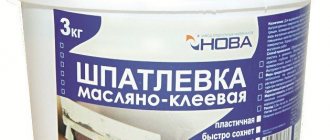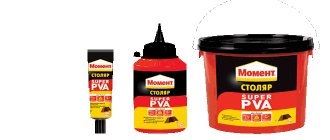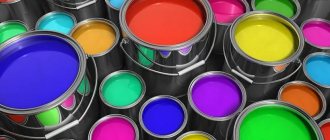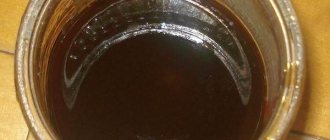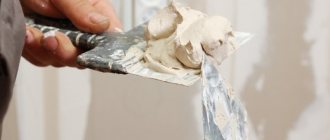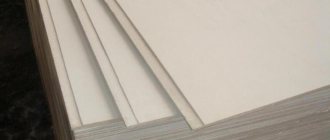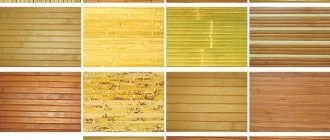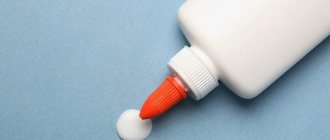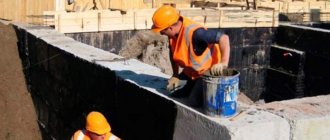Description
Gypsum particle boards (GSP) are made from natural components. They contain gypsum (80%), wood chips (15%) and water. All components are classified as environmentally friendly.
In the production process of such building materials, special machines are used that grind high-quality wood into small chips. Under further influence of the press, it is transformed into thin and fairly flexible chips. This manufacturing method makes it possible to impart valuable reinforcing properties to GSP slabs. They are ideal for interior decoration of a home.
On sale you can find regular and moisture-resistant varieties of GSP boards. The latter can be used in excessively humidified areas.
Gypsum particle boards are superior to gypsum fiber and plasterboard in many technical indicators Source i.stroy-ka.ru
Dry floor screed
What GSP is is already known, and it is clear what it is used for. In this case, it is necessary to first clear the floor of debris, and then lay out a protective polyethylene film, the edges of which must be stretched over the walls. A sheathing is placed on top of it, onto which the sheets will be subsequently attached. Expanded clay should be poured between the profiles, this will create an excellent insulator layer.
It is recommended to carry out the installation itself in several stages. The first layer is placed directly on the guides, after which it is generously smeared with PVA and becomes the basis for the next layer. It should be noted that additional fastening of the sheets together with the frame is done with self-tapping screws, which are placed in increments of a third of a meter.
The seams of the second layer slabs must completely overlap the seams of the first. It is important to know that where such a floor meets the wall, it is required to leave a technical gap of 1 centimeter on all sides. In the future, this distance will be filled with a special edge tape.
At the final stage, you will need to fill in all the recesses that were left due to the heads of the screws, and cover the resulting distances between the plates with putty. After the material has completely dried, its top layer is sanded until it fully matches the floor level.
Advantages and disadvantages
Gypsum particle board is an innovative finishing building material with multiple advantages:
- Environmental friendliness. The material consists only of natural components, meets sanitary requirements, therefore it can be used even in children's premises.
- Fire safety. GSP boards are resistant to combustion and do not emit substances harmful to humans when heated.
- Easy to install. Installing such products is not difficult; installation work does not require special skills or knowledge.
- Moisture resistance. The building material can be used in the bathroom and kitchen.
- Noise insulation. The minimum indicator of sound conductivity of the material is a huge plus when decorating floors and walls in a home.
- High strength, wear resistance. Such valuable properties are provided subsequently by reinforcing gypsum particle boards.
- Biostability. Finishing building materials are not susceptible to mold, fungi, and insects.
Flaws:
- Heavy weight. A sheet with a length of 3 m and a thickness of 1.2 cm weighs approximately 56 kg, which creates certain difficulties during its transportation and installation (especially on the ceiling).
- Can only be used indoors. Ordinary sheets are afraid of moisture and cannot be used for exterior decoration of buildings.
- Difficulty of processing. To cut sheet products, use a jigsaw or a circular saw. When using an angle grinder, a lot of dust is generated.
Important! Gypsum particle boards are able to regulate the air humidity in the room: gypsum takes excess moisture from the room, but if there is a lack, it gives it back.
Due to high levels of wear resistance and strength, GSP products can serve for a long time without signs of deformation or damage Source businessman.ru
How the marking of KNAUF sheets has changed
It can definitely be said that with the change in marking, the quality and characteristics of the sheets were not affected; it is likely that the declared supplies of cardboard from Germany improved their quality.
New marking of gypsum board sheet
The old designation GKL, a simple plasterboard sheet, was replaced by GSP-A.
According to its intended purpose, it is still the same material for construction and finishing, used for cladding interior walls of premises, installing non-load-bearing partitions and various types of suspended ceilings. In addition, it is used for the construction of decorative structures and sound absorption.
Note: All main production Knauf sheets are made with a PLUK edge, which means a semicircular thinned edge. An edge is made on the outside of the sheet and allows for better puttying of the sheet joints.
Other types of edges (flat, semicircular) are produced only to order and are quite difficult to find on open sale.
New marking of GKLV sheet
The old marking GKLV, which designated a moisture-resistant plasterboard sheet, changed the marking to GSP-N2.
In terms of purpose, this is still the same sheet building material used for cladding interior walls of premises, constructing non-load-bearing partitions and various types of suspended ceilings, BUT in rooms with high humidity.
You can distinguish a moisture-resistant sheet by the color of the cardboard. Unlike the gray color of a simple leaf, it is pale green.
Old GKLO marking
GKLO sheet meant a sheet with increased resistance to combustion, in other words, a fire-resistant sheet. New marking of GKLO, GSP-DF sheets. Reads like a GSP sheet type DF.
A distinctive feature of these types of sheets is the increased resistance of the core to fire. That is why they are used for cladding walls, installing partitions and suspended (suspended) ceilings in rooms with a high fire hazard. In addition, they are actively used for fire protection of walls and ceilings.
Old marking of GKLU sheets
The old marking of GKLU sheets meant reinforced plasterboard sheets. New marking for this type of sheet is GSP-DFH3IR.
This type of sheet is distinguished by increased core density, moisture resistance, fire resistance and impact resistance. In essence, this is an elite sheet of drywall that has absorbed all the qualities of the sheets described above. In addition, registered sheets of GSP type DFH3IR are lined with cardboard produced in Germany. It is blue.
Varieties
GSP building material is excellent for interior decoration of housing. It is usually produced in the form of smooth rectangular slabs (thickness - 0.8-2.8 cm) with straight ends. The following types of sheets exist:
- Polished. They are distinguished by a polished surface on the front (sometimes also on the back) side.
- Folded. There are folds at the ends of the products (up to 3 cm deep).
- Moisture resistant (GSPV). Treated with hydrophobic compounds. They completely clog the pores and prevent the material from absorbing water.
The produced sheets come in different sizes: the common thickness of the products is 8-12 mm, width - 125 cm, length - 0.5-3 m. The variety of panels in size greatly facilitates construction work.
Moisture-resistant gypsum particle boards can be used to decorate bathrooms and kitchens Source stroy-podskazka.ru
State social assistance based on a social contract
SHG from social protection is provided on the basis of a social contract - an agreement concluded between a low-income family (or citizen) and the center for social protection of the population. To conclude this agreement, you need to contact the social security department at your place of residence with the necessary documents and tell the service employees in detail about the family’s financial problems.
You will also need to fill out. In the future, a special commission may be created that will visit the applicant, assess his living conditions and draw up a report on it.
All information provided by the applicant will be carefully checked.
Social security employees send requests to the tax service, the Pension Fund, Rosreestr and other departments to make sure that the family really needs financial assistance and is not hiding its income. Typically, the verification lasts up to 25 days from the moment the citizen applies.
If the family’s situation is really difficult, social security will develop a special adaptation plan indicating the type and amount of financial assistance, as well as the requirements that must be met (Article 8.1 of the SHG Law).
State assistance on the basis of a social contract is not provided just like that - the recipient of this support measure must report on what he spent the funds allocated to him on. For example, if money was given to buy medicine for a child or for training courses, you need to confirm that the medicine was actually bought and that classes were not skipped.
Features of installation of GSP slabs
When fastening gypsum particle board products, special tools are not used. A standard set of devices designed for finishing activities is suitable.
Installation of slabs on metal or wood bases is carried out using screws. Round nails are used for fastening to wood. The fastening elements should extend (at an angle of 90°) into the iron frame by 1 cm, into the wooden frame by 2 cm. To make it convenient to putty the surface later, the heads of the screws or nails should be “recessed” into the base.
The joining of gypsum particle boards with a straight edge is carried out taking into account a small gap (5 mm). To fill the joints, a special gypsum mixture is used, it is laid out in a dense layer. If there is a seam edge, the installation is done end-to-end, and the joints are filled using reinforcing tape.
When fastening single-layer sheathing, screws (3 cm long) are installed in increments of 2.5 cm. If a two-layer construction is provided, the step length for the initial layer is 7.5 dm, for the subsequent one - three times less.
Important! Gypsum particle boards can be mounted to load-bearing frames, as well as glued to the surface. The latter must certainly be smooth, without differences of more than 2 cm.
The difficulty of sawing GSP lies in the considerable weight of the products and the release of a large amount of gypsum dust Source cdn.vox-cdn.com
Main characteristics
GSP, or more generally gypsum particle board, is a relatively recently appeared material. Only a few companies are engaged in the production of such goods in Russia. A significant part of the products is imported from abroad, and therefore is quite expensive. The share of gypsum is up to 83%, shavings - a maximum of 15%, the remaining mass is water and special improving additives; Due to cellulose fibers, the sheet becomes stronger.
The original wood raw materials are cleaned and crushed. Humidification is produced, making the connection as reliable as possible. Gypsum, modifying substances and a certain amount of liquid are added to the shavings. The resulting mass, as soon as it reaches the required consistency, is placed under a press. There it is formed properly.
Wood-gypsum board is quite durable. Its density reaches 1250 kg per 1 m3. Such a product will bear significant loads in the longitudinal and transverse planes
What is important is that it has high bending resistance. Standard resistance varies from 8 to 16 MPa
The exact value of the parameter is determined by the thickness of the specific element.
GSP is extremely environmentally friendly. No toxic substances are used in its production. However, it must be taken into account that when working with the material, a suspension may form. Therefore, installers must use respirators. Their fire safety also speaks in favor of gypsum particle boards.
The spread of fire is effectively restrained precisely by the presence of gypsum. Even if the structure is subjected to excessive heating, toxic substances will not be released. In addition, gypsum particle board is moisture resistant - typical options absorb up to 30% of liquid in 120 minutes of “bathing”. Specialized components can reduce this figure by another 3 times. GSP perfectly suppresses extraneous sounds (the sound insulation index is 32-35 dB), in addition, this material will help improve the energy efficiency of the building.
Video description
How to cover bathroom walls with GSP gypsum particle board.
Partitions
Due to their high strength and excellent noise-insulating properties, gypsum particle board products are best suited for the construction of all kinds of partition structures. The basis for the latter is a frame (wooden, iron), which is securely attached to the walls, ceiling, and floor. It gives the partition stability and helps create a flat surface.
Partition structures are also used to enclose communications. To do this, a box is created around the wires or pipes, then it is carefully lined with gypsum board material, and the joints are puttied. At the end, the entire surface is finished in any available way.
The optimal thickness of gypsum particle board material for cladding partitions is 8-10 mm Source stroy-podskazka.ru
Application
Based on technical features, such sheet materials occupy a significant place in finishing and facing works, as well as in the installation of small frame structures, and in the installation of multi-level ceilings and partitions. The use of GSP is especially important in places where increased sound insulation, fire safety and resistance of the floor and wall to point and impact loads are required.
In frame construction, the material is often used as an alternative to expensive OSB and less durable drywall. Such sheets are also very often used for installing door and window openings, as well as window sills.
What is a letter from the OC?
OT stands for “declared value”. A notification from this category informs about a valuable letter, the sender of which wished to receive a confirmation of delivery of the correspondence. If such a letter is lost, it is the responsibility of the postal service to reimburse its cost.
Interesting materials:
What cookware should not be used on an induction cooker? What bird can be taught to speak? What role did Helen Kuragina play in the fate of Natasha Rostova? What kind of fish can be used for frying? Which hat to wear with a black down jacket? Which frying pan should you choose for frying meat? What kind of mixture is given at the dairy kitchen in Moscow? What oxidation state and valency does chlorine exhibit in compounds? How much can you withdraw from Sberbank through the cash desk? What tablet should I put in flowers to make them last longer?
General information about the material
SHGs first appeared in the early 80s of the last century. The Finns were the first to help, purchasing the rights to create these components at their SasmoX company facilities. As a result, the first slabs rolled off the assembly line in 1985 and immediately began to become popular.
In Russia, until 2010, these slabs were produced on high-quality German equipment within the walls of the Peshelansky gypsum plant. Nowadays, PGZ Decor-1 LLC has become a well-known manufacturer of this finishing component on Russian territory.
